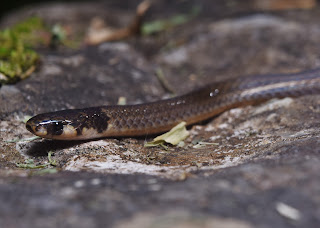 |
| Photo by Renoir Auguste |
The William Beebe Research Station, also known as Simla is known by many scientists that have visited Trinidad. It is located in the Arima Valley and surrounded by tropical forests: ideal for researchers wanting to get a feel of the environment. However, over recent years the nearby quarry has altered the habitat. One wonders what kind of effect this may have on the wildlife, including the local herpetofauna?
 |
| Tantilla melanocephala. Photo by Rainer Deo |
In October 2018 the Trinidad and Tobago Field Naturalists' Club's Herpetology Group, lead by current president undertook a trip to see what amphibian and reptile species they can find. Searches took place in the afternoon from 2:30 pm to 3:30 pm and then again at night from 6 pm to 9 pm. Within those 4 hours, the group collectively observed 17 herpetofauna species, including 3 snake species (Bothrops sp, Tantilla melanocephala, and Corallus ruschenbergerii), 6 lizard species (Hemidactylus mabouia, Thecadactylus rapicauda, Gonatodes vittatus, G. ceciliae, Anolis planiceps, and Plica caribeana), and 8 amphibian species (Mannophryne trinitatis, Rhinella marina, Pristimantis urichi, Flectonotus fitzgeraldi, Boana xerophylla, Leptodactylus validus, Engystomops pustulosus, Phyllomedusa trinitatis).
 |
| Thecadactylus rapicauda. Photo by Rainer Deo |
It was a bit surprising given the warm afternoon and relatively dry conditions at night to see that many species. Although most of these may be considered generalist type species, the habitat specialists (Pristimantis urichi and Flectonotus fitzgeraldi) were visually and audibly observed. This may suggest that the forest at and around Simla does offer suitable habitat for these species, for now. It would be interesting to regularly keep track of the diversity of herpetofauna at Simla.
 |
| Rhinella marina (background) and Pristimantis urichi (foreground) at Simla. Photo by Rainer Deo |

No comments:
Post a Comment